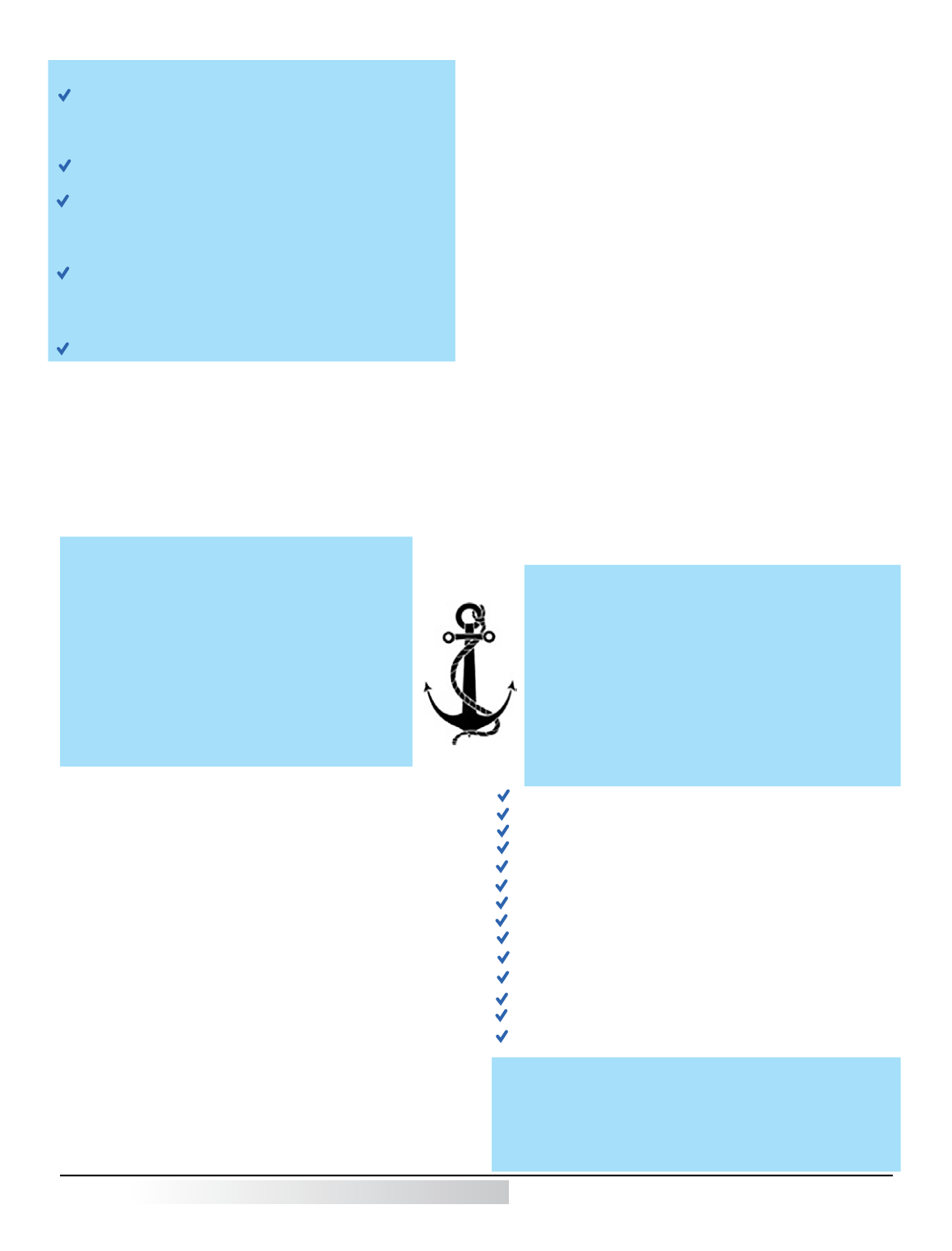

April 2017
79
boatingonthehudson.com
Examine Gelcoat
Check deck and hull for oxidation, gelcoat cracks
,scratches, gashes, airvoids, etc. It’s best to repair
any gelcoat problems sooner than later to avoid
worse problems and more expense down the road.
Check for osmotic blisters. Repair is highly
recommended.
Reglaze and wax if your hull was cleaned
with an acid wash ( e.g. On-Off ) All the gelcoat
sealer protecting properties are gone and need
replacing!
If your boat is going to be in the water all
season, consider applying epoxy barrier on hull
from the waterline down to help prevent osmotic
blistering
Touch up or replace antifouling paint.
Hardware check
Tighten screws, nuts, bolts,etc on bow eyes,
seating, cleats, ladders, swim platform bolts,
windlass, railings, antennas, electronics,
windshields, rub rails, engine and transom,
biminis, hatch doors, etc
While you are at it clean and polish metal with a
good metal polish
Marine Sealants
I often see soaked up and rotted core material
in the area of decks, around cleats, floors,
transoms, window frames, engine hatch covers,
seat bases, under rub rails,hull/deck joints,
port lights,etc. If there are any areas of peeling
and/or missing sealant it is an invitation for
problems. It must be removed and replaced.
Never use silicone! I’m not a fan of it. In my
opinion there is no place on a boat to use
silicone. It dries out, flakes, shrinks and falls
out. Use Marine Sealant, I favor 3M
There is a sealant specific to each
application.
Be sure to use the right one for the job. Here’s
technical info from 3M that will be helpful.
• Sealant 101
– High quality polysulfide bedding
and deck seam sealant. Chemically cures to form a
firm, rubbery water tight seal. Use above and below
water line. Seals between mechanically fastened
joints on wood, metal, fiberglass and most plastics.
Becomes tack free in 5 hrs and remains permanently
flexible. Has excellent resistance to chemicals and
weathering, salt water, and stress caused by joint
movement.
• 3M Adhesive Sealant Fast Cure 4000UV
-
Superior UV resistant, remains flexible, use above
& below water line. Good for sealing deck to hull
joints, thru- hull fittings, window and door frames,
deck hardware, etc.
• 3M Adhesive/Sealant 5200
- Workable up to 4
hrs, tack free in 48 hrs, cures 5-7 days. No shrinkage
remains flexible, won’t sag or flow, bonds and seals
well. Use above & below water line. Excellent resistance
to weathering and salt water. Note- this is a permanent
sealant! You could do damage to your boat taking it
apart, so use wisely!
• 3M Adhesive/Sealant Fast Cure 4200-
General
all purpose polyurethane that chemically reacts with
moisture to deliver flexible bonds with good adhesion
to fiberglass, gelcoat, wood, plastics and metals. Paint-
able and sand-able. Not recommended for sealing wood
decks. Teak cleaners or sealers may soften it. Forms
water tight and weather-resistant seals on joints and
hardware.
• 3M Adhesive/Sealant Fast Cure 5200
– Tack free
in one hour, fully cures in 24 hrs. Seal is exceptionally
strong and stays flexible. It retains strength above and
below water line. Won’t sag or flow. Bonds and seals port
holes and deck fittings, motors on fiberglass transoms,
under moldings, etc. Note- this is a permanent sealant!
You could do damage to your boat taking it apart, so
use wisely!
Trailer inspection
Have your trailer serviced by your favorite marina
or do-it-yourself. Inspecting and servicing and
having it in good condition is easier than doing it
on the shoulder of I87. We are currently repairing
a beautiful Roth boat that has a 13’ long deep
gash on the hull caused by a roller that fell off the
trailer. The owner was unaware the roller fell off
and damaged the boat when he put it back on the
trailer. Needless to say the owner was not happy.
The damage could have been avoided if the trailer
was maintained.
Check and lubricate wheel bearings
Examine bunks, rollers and pads – tighten
loose screws, bolts
Check bunk carpet for wear – replace worn out,
old, sandy, gritty carpet
Clean and lubricate winch- check strap/rope
Check hitch
Lubricate tongue jack and wheel
Test lights and electrical connections
Check tire pressure and condition
Check surge brakes (if equipped)
Check safety chains
Check tongue lock
Have current registration and inspection sticker
Canvas
Clean and treat canvas and biminis with waterproofing
if needed. Repair or replace as needed. Canvas helps
protect gelcoat from penetrating UV sun rays.

















